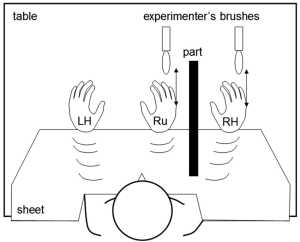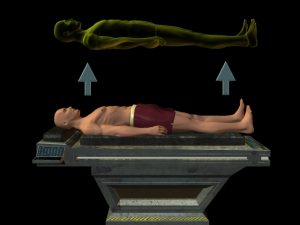4.5 Consciousness
Conscious Experiences

Contemplate the unique experience of being you at this moment! You, and only you, have direct knowledge of your own conscious experiences. At the same time, you cannot know consciousness from anyone else’s inside view. How can we begin to understand this fantastic ability to have private, conscious experiences?
In a sense, everything you know is from your own vantage point, with your own consciousness at the center. Yet the scientific study of consciousness confronts the challenge of producing a general understanding that goes beyond what can be known from one individual’s perspective.
To delve into this topic, some terminology must first be considered. The term consciousness can denote the ability of a person to generate a series of conscious experiences one after another.
Here we include experiences of feeling and understanding sensory input of a temporal sequence of autobiographical events, of imagination, of emotions and moods, of ideas, of memories—the whole range of mental contents open to an individual.
Consciousness can also refer to the state of an individual, as in a sharp or dull state of consciousness, a drug-induced state such as euphoria, or a diminished state due to drowsiness, sleep, neurological abnormality, or coma. In this module, we focus not on states of consciousness or on self-consciousness but rather on the process that unfolds in the course of a conscious experience—a moment of awareness—the essential ingredient of consciousness.
Other Minds
You have probably experienced the sense of knowing exactly what a friend is thinking. Various signs can guide our inferences about consciousness in others. We can try to infer what’s going on in someone else’s mind by relying on the assumption that they feel what we imagine we would feel in the same situation. We might account for someone’s actions or emotional expressions through our knowledge of that individual and our careful observations of their behavior. In this way, we often display substantial insight into what they are thinking. Other times we are completely wrong.
By measuring brain activity using various neuroscientific technologies, we can acquire additional information useful for deciphering another person’s state of mind. In special circumstances such inferences can be highly accurate, but limitations on mind reading remain, highlighting the difficulty of understanding exactly how conscious experiences arise.
A Science of Consciousness

Attempts to understand consciousness have been pervasive throughout human history, mostly dominated by philosophical analyses focused on the first-person perspective. Now we have a wider set of approaches that includes philosophy, psychology, neuroscience, cognitive science, and contemplative science (Blackmore, 2006; Koch, 2012; Zelazo, Moscovitch, & Thompson, 2007; Zeman, 2002).
The challenge for this combination of approaches is to give a comprehensive explanation of consciousness. That explanation would include describing the benefits of consciousness, particularly for behavioral capabilities that conscious experiences allow, that trump automatic behaviors. Subjective experiences also need to be described in a way that logically shows how they result from precursor events in the human brain. Moreover, a full account would describe how consciousness depends on biological, environmental, social, cultural, and developmental factors.
At the outset, a central question is how to conceive of consciousness relative to other things we know. Objects in our environment have a physical basis and are understood to be composed of constituents, such that they can be broken down into molecules, elements, atoms, particles, and so on. Yet we can also understand things relationally and conceptually. Sometimes a phenomenon can best be conceived as a process rather than a physical entity (e.g., digestion is a process whereby food is broken down). What, then, is the relationship between our conscious thoughts and the physical universe, and in particular, our brains?
Rene Descartes’ position, dualism, was that mental and physical are, in essence, different substances. This view can be contrasted with reductionist views that mental phenomena can be explained via descriptions of physical phenomena. Although the dualism/reductionism debate continues, there are many ways in which mind can be shown to depend on brain.
See below for videos outlining these perspectives on consciousness. The first is an interview with Ned Block who explains the debate more broadly but ultimately holds a more reductionist (physical) approach. The second is a TED Talk by David Chalmers who proposes that subjective experience can’t be reduced to biological processes and that we must conceive of it in other ways.
A prominent orientation to the scientific study of consciousness is to seek understanding of these dependencies—to see how much light they can shed on consciousness. Significant advances in our knowledge about consciousness have thus been gained, as seen in the following examples.
Conscious Experiences of Visual Perception

Suppose you meet your friend at a crowded train station. You may notice a subtle smile on her face. At that moment you are probably unaware of many other things happening within your view. What makes you aware of some things but not others? You probably have your own intuitions about this, but experiments have proven wrong many common intuitions about what generates visual awareness.
For instance, you may think that if you attentively look at a bright spot, you must be aware of it. Not so. In a phenomenon known as motion-induced blindness, bright discs completely vanish from your awareness in full attention. To experience this for yourself, see the video below.
You may think that if you deeply analyze an image, decoding its meaning and making a decision about it, you must be aware of the image. Not necessarily. When a number is briefly flashed and rapidly replaced by a random pattern, you may have no awareness of it, despite the fact that your brain allows you to determine that the number is greater than 5, and then prepare your right hand for a key press if that is what you were instructed to do (Dehaene et al., 1998).
Thus, neither the brightness of an image, paying full attention to it, nor deeply analyzing it guarantees that you will be aware of it. What, then, is the crucial ingredient of visual awareness?
A contemporary answer is that our awareness of a visual feature depends on a certain type of reciprocal exchange of information across multiple brain areas, particularly in the cerebral cortex. In support of this idea, directly activating your visual motion area (known as V5) with an externally applied magnetic field (transcranial magnetic stimulation) will make you see moving dots. This is not surprising. What is surprising is that activating your visual motion area alone does not let you see motion. You will not see moving dots if the feedback signal from V5 to the primary visual cortex is disrupted by a further transcranial magnetic stimulation pulse (Pascual- Leone & Walsh, 2001). The reverberating reciprocal exchange of information between higher-level visual areas and primary visual cortex appears to be essential for generating visual awareness.
This idea can also explain why people with certain types of brain damage lack visual awareness. Consider a patient with brain damage limited to primary visual cortex who claims not to see anything — a problem termed cortical blindness. Other areas of visual cortex may still receive visual input through projections from brain structures such as the thalamus and superior colliculus, and these networks may mediate some preserved visual abilities that take place without awareness. For example, a patient with cortical blindness might detect moving stimuli via V5 activation but still have no conscious experiences of the stimuli, because the reverberating reciprocal exchange of information cannot take place between V5 and the damaged primary visual cortex. The preserved ability to detect motion might be evident only when a guess is required (“guess whether something moved to the left or right”)—otherwise the answer would be “I didn’t see anything.” This phenomenon of blindsight refers to blindness due to a neurological cause that preserves abilities to analyze and respond to visual stimuli that are not consciously experienced (Lamme, 2001). Find a video offering a quick explanation of this phenomenon below.
If exchanges of information across brain areas are crucial for generating visual awareness, neural synchronization must play an important role because it promotes neural communication. A neuron’s excitability varies over time. Communication among neural populations is enhanced when their oscillatory cycles of excitability are synchronized. In this way, information transmitted from one population in its excitable phase is received by the target population when it is also in its excitable phase. Indeed, oscillatory neural synchronization in the beta- and gamma-band frequencies (identified according to the number of oscillations per second, 13–30 Hz and 30–100 Hz, respectively) appears to be closely associated with visual awareness. This idea is highlighted in the Global Neuronal Workspace Theory of Consciousness (Dehaene & Changeux, 2011), in which sharing of information among prefrontal, inferior parietal, and occipital regions of the cerebral cortex is postulated to be especially important for generating awareness.
A related view, the Information Integration Theory of Consciousness, is that shared information itself constitutes consciousness (Tononi, 2004). An organism would have minimal consciousness if the structure of shared information is simple, whereas it would have rich conscious experiences if the structure of shared information is complex. Roughly speaking, complexity is defined as the number of intricately interrelated informational units or ideas generated by a web of local and global sharing of information. The degree of consciousness in an organism (or a machine) would be high if numerous and diversely interrelated ideas arise, low if only a few ideas arise or if there are numerous ideas but they are random and unassociated. Computational analyses provide additional perspectives on such proposals. In particular, if every neuron is connected to every other neuron, all neurons would tend to activate together, generating few distinctive ideas. With a very low level of neuronal connectivity at the other extreme, all neurons would tend to activate independently, generating numerous but unassociated ideas. To promote a rich level of consciousness, then, a suitable mixture of short-, medium-, and long-range neural connections would be needed. The human cerebral cortex may indeed have such an optimum structure of neural connectivity. Given how consciousness is conceptualized in this theory as graded rather than all-or-none, a quantitative approach (e.g., Casali et al., 2013; Monti et al., 2013) could conceivably be used to estimate the level of consciousness in nonhuman species and artificial beings.
Conscious Experiences of Body Awareness

The brain can generate body awareness by registering coincident sensations. For example, when you rub your arm, you see your hand rubbing your arm and simultaneously feel the rubbing sensation in both your hand and your arm. This simultaneity tells you that it is your hand and your arm. Infants use the same type of coincident sensations to initially develop the self/nonself distinction that is fundamental to our construal of the world.
The fact that your brain constructs body awareness in this way can be experienced via the rubber-hand illusion (an example of which is provided in the Perception content). If you see a rubber hand being rubbed and simultaneously feel the corresponding rubbing sensation on your own body out of view, you will momentarily feel a bizarre sensation—that the rubber hand is your own.

The construction of our body awareness appears to be mediated by specific brain mechanisms involving a region of the cortex known as the temporoparietal junction. Damage to this brain region can generate distorted body awareness, such as feeling a substantially elongated torso. Altered neural activity in this region through artificial stimulation can also produce an out-of- body experience, in which you feel like your body is in another location and you have a novel perspective on your body and the world, such as from the ceiling of the room.
Remarkably, comparable brain mechanisms may also generate the normal awareness of the sense of self and the sensation of being inside a body. In the context of virtual reality this sensation is known as presence (the compelling experience of actually being there). Our normal localization of the self may be equally artificial, in that it is not a given aspect of life but is constructed through a special brain mechanism.
A Social Neuroscience Theory of Consciousness (Graziano & Kastner, 2011) ascribes an important role to our ability to localize our own sense of self. The main premise of the theory is that you fare better in a social environment to the extent that you can predict what people are going to do. So, the human brain has developed mechanisms to construct models of other people’s attention and intention, and to localize those models in the corresponding people’s heads to keep track of them. The proposal is that the same brain mechanism was adapted to construct a model of one’s own attention and intention, which is then localized in one’s own head and perceived as consciousness. If so, then the primary function of consciousness is to allow us to predict our own behavior. Research is needed to test the major predictions of this new theory, such as whether changes in consciousness (e.g., due to normal fluctuations, psychiatric disease, brain damage) are closely associated with changes in the brain mechanisms that allow us to model other people’s attention and intention.
Conscious Experiences of Decision-Making
Weighing our options individually (conscious mode) vs. going with our gut or instinctual feeling (unconscious mode) are two ways we make decisions. The ‘gut feeling’ mode allows us to evaluate numerous factors alongside one another at the same time, leaving us with an overall gut instinct. In the conscious decision-making mode, we examine each factor thoroughly. We have to keep in mind that zeroing-in on an individual factor can restrict evaluating other considerations. Therefore, the careful analysis approach to decision making will most likely work well when there are fewer factors to consider, while a gut decision may be more effective when a large number of factors have to be considered. Keep in mind that though gut decisions can be accurate, they are not always correct either.
Whichever mode of decision-making we choose, it’s important to ask ourselves if we feel that we freely came to our decisions. In an experiment, people were asked to freely choose whether or not to press the right or left button, and then actually press the button. Interestingly, although they pressed the button right away, their brain activity pattern predicted their decisions as much as 10 seconds before they made their decision. Is each conscious experience preceded by precursor brain events that lead to consciousness? On the other hand, it does seem that we are in control of some decisions (e.g., we can decide whether to go right or left). Alternatively, we may have evolved to believe in free choice as it is a beneficial trait and helps us succeed as social beings.
Understanding Consciousness
Due to the fact that our conscious experiences are subjective, people have thought that we cannot study consciousness scientifically. However, a logical empirical account of the world cannot avoid subjectivity as it has a place in science. Conscious experiences can be studied systematically to further our understanding and many questions still remain. For example, do individuals have different first-person accounts of their conscious experiences? Can training, such as through meditation and introspection, generate a type of expertise in terms of consciousness? Future work is needed to address these and other related scientific questions!
The first-person perspective of a mental event, such as feeling some sensory input, a memory, an idea, an emotion, a mood, or a continuous temporal sequence of happenings.
Perception or knowledge of something; often viewed as a component of consciousness, though it may be possible to be “aware” of something without being explicitly conscious of it.

